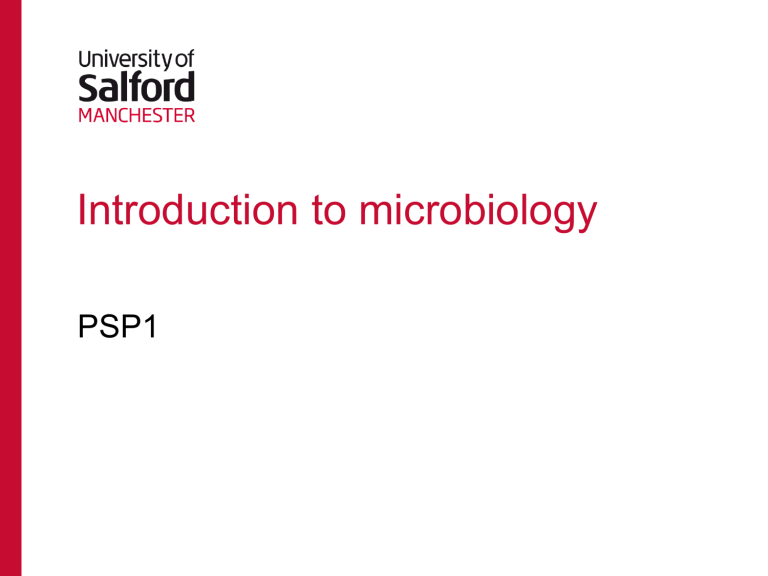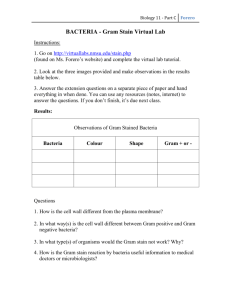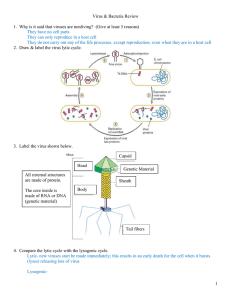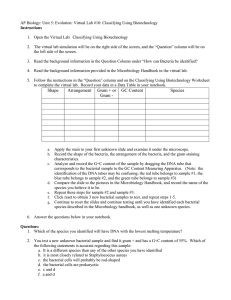intro to microbiology updated

Introduction to microbiology
PSP1
virus
virus
• Smallest known infective agent
• Most forms of life a susceptible to viral infectionhumans, animals, plants, bacteria
• Need a host to replicate
• Requires entry to the host
– Respiratory tract
– Alimentary tract ( oral –faecal route)
–
Blood
– Sexual intercourse
–
Skin abrasions
• Basically :
• a core of nucleic acid ( contains genetic material DNA/RNA) surrounded by a protein coat
• Outer protein envelope
replication
• Often protein envelope partially derived from the host cell
• Virus always replicate INSIDE a host cell
• Fragile outside a host cell
1. Cause cell lysis- viral DNA replicated
2. Remain latent within the cell , divide with the cells natural division , virus DNA is replicated during this division
1. THEN cause lysis
• Different virus attack different cells depending on the RECEPTOR SITE
• Systemic - spreads widely and infects many tissues and organs e.g. measles
• Localised - invades only tissues adjacent to the site of entry e.g respiratory viral infections/ verrucae
• Main defence of the body is to produce the protein interferon
• Interferon is released by infected cells and taken up by other cells
• Antibodies appear in the patient's serum- this leads to immunity or resistance
Hepatitis
• Hepatitis A, Hepatitis B, and Hepatitis C are diseases caused by three different viruses
• different modes of transmission and can affect the liver differently.
–
Hep A- ingesting faecal matter ( often associated with developing countries/travel)
– Hep B- blood/body fluid
– Hep C- blood/body fluid
• There are vaccines to prevent Hepatitis A and B; however, there is not one for Hepatitis C.
HIV
• Human immunodeficiency virus
• AIDS- final stage of HIV infection
• 1 in 5 affected people do not know they have the virus
• Transmitted through:
– Unprotected sex
– Mother-baby
– Contaminated needles
bacteria
• Single cell organisms
• Classified in different ways ( three parameters):
• Shape- morphology
• Colour ( Gram staining)
• Growth requirements-Need for oxygen
naming
• Bacteria are named with 2 words ( genus + species)
• Staphylococcus aureus shortened to S.aureus
morphology
• Sphere ( cocci)
– Staphylococcus – spheres bunch together
– Streptococci- spheres form a chain
• Rods ( bacilli)
• Spiral (spirochaetes)
Gram staining
• Gram positive and gram negative refers to how a bacteria reacts to a gram stain.
• Chrystal violet then iodine
• If it takes the initial stain, it will be purple and be considered gram positive.
• If it doesn't take the initial stain, it will be pink and gram negative .
Positive and negative
• The difference is the outer casing of the bacteria.
• A gram positive bacteria will have a thicker layer of peptidoglycan (a sugar-protein shell)
• A gram negative bacteria has an outer membrane covering a thin layer of peptidoglycan on the outside.
Growth requirements
• Aerobes need oxygen and are found on wound surfaces
– E.g. Pseudomona aeruginosa
• Anaerobes cannot survive where there is oxygen and are found deep in wounds
– E.g. Clostridium welchii – causes gas gangrene
Cultured on an agar plate
Staphylococcus aureus
• Gram positive
• Staphylococcus aureus is a bacterium that commonly colonises human skin and mucosa
(e.g. inside the nose) without causing any problems.
Normal body flora
• Common wound infector- may lead to cellulitis
• Methicillin Resistant Staphylococcus aureus
Pseudemonas aeruginosa
Common wound pathogen
Gram negative
Pyocyanin – green pigment secreted by the bacteria
One of the most worrisome characteristics of P. aeruginosa is its low susceptibility to antibiotics
Streptococcus pyogenes
( group A strep)
• Gram positive
• Faculative anerobe ( can survive with or without oxygen)
• Part of normal flora in many people’s throats
• Can cause simple infections ( sore throat) to life threatening infections
• Most frequent pathogen in humans
Streptococcus pyogenes
• Strep throat
• Purulent infections
• cellulitis
• impetigo
• necrotising fasciitis ( flesh eating)
• Can lead to toxic shock
group G Strep
• MAY be found as part of normal skin flora
• Normally infections in patients with other comorbidities e.g
diabetes
• Wound infector
• Can spread and cause extensive infections: e.g.
• Bacteriamia
• Septic shock
f
FUNGI
Fungal hyphae
Multicellular fungi are composed of filaments called ‘hyphae’
• More complex organism than bacteria
• Reproduce by spore formation ( released by splitting hyphae) or sexual reproduction ( mix chromosomes)
• Cell wall+ cell membrane
• Ergesterol essential element of the cell membrane – provides stability and flexibility
fungi on skin and nails
DERMATOPHYTES infect keratinous material
NON-DERMATOPHYTES
Yeasts or moulds
Fungi cannot manufacture their own food.
Dermatophytes ingest keratin as their food source
dermatophytes affecting the skin and nails
• 3 genera
– Trichophyton
– Epidermophyton
– Microsporum
• all endemic to communal areas
Pathology
First result
Potassium hydroxide wet mount – dissolves
Keratin leaving resistant Fungal hyphaeseen through microscope
Second result
Fungal culture- agar plate
Therefore 2 weeks for results to be returned from the pathology laboratory







